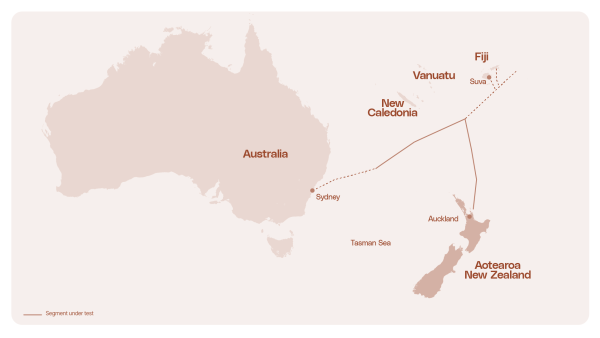Turning internet cables into seismometers
Case study
International collaboration repurposes existing cable across the Tasman

The Challenge
Aotearoa New Zealand’s location – astride a plate boundary – makes the country one of the most seismically-active countries in the world. And while we have an extensive land-based seismic monitoring network, the same is not true for the oceans surrounding our islands. This lack of ocean-based monitoring limits the reach of our national hazard response preparedness system, especially for detecting and measuring offshore earthquakes and tsunamis.
With locally-damaging tsunamis striking some part of Pacific Ocean basin every 1 – 2 years on average, there is an urgent need to address the gaps in our seismic monitoring system. UNESCO-IOC’s Ocean Decade Tsunami Programme was established to drive improvements in the global tsunami warning system by reducing response times and enhancing community readiness. One of its goals it to “provide tsunami confirmation within 10 minutes or less of origin for the most at-risk coastlines.” This 10-minute goal cannot be met with the existing land-based seismic network.
The Metrology Solution
In 2021, scientists from the UK’s metrology institute, the National Physical Laboratory (NPL), developed a measurement technique that could turn subsea telecoms cables into environmental sensors and seismometers. Called optical interferometry, the technique involves sending light from an ultra-stable laser along an existing fibre-optic cable and measuring small variations in the signals that return from every in-line amplifier (“repeater”) along the cable. Because these variations are related to changes in the strain experienced by the cable, careful analysis of these signals can unveil signatures of earthquakes, ocean currents and potentially, tsunamis.
Previous tests of the technique had been carried out on a seafloor cable between the UK and Canada. In 2024, NPL, initiated a new trial across the Tasman Sea, a region chosen for its high seismic activity, with installation support from MSL.
The MSL team, funded through a Quantum Technologies Aotearoa (QTA) Starter Project, carried out the field installation of the interferometric system at the Southern Cross NEXT cable landing station in Takapuna, Auckland, in August 2024, working with NPL both in-person and remotely. Access to the cable network was made possible through the support and collaboration of Southern Cross, whose partnership is central to the success of this programme.
Additional QTA funding will strengthen the collaboration. Upcoming work includes installing a new, high-stability laser at the Takapuna landing station to improve the sensitivity and range of the current measurement system, producing more accurate readings that can be used to inform future tsunami and earthquake risk assessments.
Our expertise in time, frequency and length sits at the centre of this effort to improve and expand New Zealand’s national hazard preparedness network.
The Impact
MSL and NPL are collaborating closely with tsunami and earthquake researchers at Earth Sciences NZ to analyse and interpret the data from the interferometer. In the first year of operation, the system detected signatures of more than 100 seismic events, including both local and regional earthquakes.
This interferometry technique does not require the addition of any hardware or infrastructure on the seafloor, and no changes are made to the cable itself, nor to its normal operation. This greatly reduces the cost and complexity of the installation process, and minimises the barriers to the technique’s potential wider adoption.
The primary goal of this project is to demonstrate the potential of subsea cables for earthquake and tsunami detection in offshore areas. Long-term, the hope is that metrology-based techniques like interferometry could enable a worldwide network of much-needed environmental and seismic sensors, using existing subsea infrastructure.
“This approach is effectively tantamount to having around 70 additional tsunami sensors lined up like infantry on the Southwest Pacific seafloor, poised to alert us to a tsunami threat the instant a significant change is detected in the ocean.”
- Dr Bill Fry, Seismo-tectonophysicist, Earth Sciences NZ

Graphic courtesy of Earth Sciences NZ
